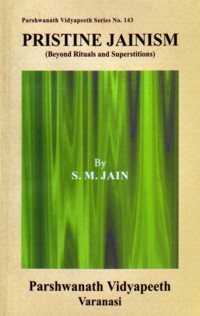There is so much emphasis on non-violence in Jainism that it has become its distinguishing mark and its synonym. Every true Jain should not commit violence in any form to any living being. Life forms have been classified according to the number of senses present in a particular life-form. Those with only one sense of touch (Sparsha) are Earth (including all types of minerals in undetached form), Air, Water, Fire and Plants (vegetation). Next category is of those with two senses of touch (Sparsha) and taste (Rasna) such as larvae. The third category has three senses of touch, taste and smell (Ghrana) such as ants. The fourth category has four senses of touch, taste, smell and sight or vision (Chakshu) as bees. The fifth category has all the five senses of touch, taste, smell, sight and hearing (Karna) such as animals, human beings etc. According to prevailing interpretation the more the number of senses, greater is the pain, callousness and hardening of heart in killing or harming. Monks or saints are required to abnegate violence to any life form. The house holders in agriculture based model (which replaced original forest based model) cannot do without some injury (violence) to life forms with one sense viz earth, air, water, fire and plants. However, there are well defined rules so that harm (violence) is minimum. Use of water, minerals, fire, plants should be as frugal as possible. Violence with intention (Sankalpihinsa) and through carelessness (Pramad) is strictly prohibited. Carelessness and laziness which includes laissez faire attitude (Pramad) which also means lack of systematic, disciplined, simple, frugal and regular life style is considered the greatest sin as it is the root cause of avoidable violence, many wrong doings, consumerism, waste, pollution etc.
Jain house holders are forbidden consumption of five types of ficus fruits e.g. bar, pipal and also meat, wine and honey. Ficus fruits are widely eaten by variety of birds and insects, which are vital agents for pollination in plant kingdom. Likewise honey bees are most active agents for pollination. Without these agents there will be no fruiting, seeding in plants and would adversely affect the production of food essential for survival of animals and humans both herbivorous and carnivorous. The carnivore though prey and feed on animals but such prey is herbivorous and survive on plants. This prescription thus not only minimises violence but also promotes and preserves symbiotic model.
Taking meals before sunset and after sunrise has been an identification mark of Jains traditionally. This is not only to avoid violence to insects and other small organisms, which are not clearly visible in night but also for better health. Medical science endorses this traditional practice on scientific basis that there should be at least four hours gap between meals and sleep for better digestion By restricting intake of food before sunset this gap is automatically maintained. People taking meals after sunset in night generally go to sleep soon after and suffer from digestive problems. In houses where dinner time is in night, food is also generally cooked in night and there are numerous cases on record of poisoning of cooked food by falling and mixing of harmful creatures in it and causing serious ailments and even deaths. The entire Jain community of all sects and subsects was till recently only 5-6 decades back was so strict about meals before sunset that even marriage ceremonies were postponed midway and not carried to final end if this practice was not adhered to by any of the parties. It is a sad travesty that same Jains now-a-days feel proud by arranging late night dinners. Jains still adhering to the tradition of meals before sunset are fast dwindling in numbers and it is almost missing in younger generation. For centuries and millennia the practice of meals before sunset was prevalent in all communities particularly in rural India. The concept of late lunch and dinner developed and took roots during British rule. The Britishers were rulers and were here to enjoy. In their own country and in Europe and America most of working populace take supper, their evening meals before sunset. The general practice there is to take good breakfast and take very light snacks and beverage at lunch time because heavy lunch was conducive to more accidents in factories. After return from work in the evening, the worker feels hungry and therefore the principal evening meal is supper before sunset. We have copied their wrong practices and not good ones. It is not only regrettable but shameful for at least Jain community to have gone astray in abandoning the scientifically sound tradition of meals during day time only.
The other well-known identification of Jains was to take water only after proper filtering in a clean double folded cloth. In one of the reports of World Health Organisation it is mentioned that in areas where guiny worm disease is prevalent it does not affect the Jains because they take water after proper filtering. Even such a scientifically authenticated practice is vanishing fast particularly in younger generation. There is important rule in scriptures about filtering. The cloth used for filter should be dipped back in the water source so that the tiny organisms are back in their congenial environment. Such an ecological concern now well recognised in modern environmental science is unique in Jainism. Another example is that the Jain monks while moving from shade to sunlight and vice-versa clean their body by softest broom of peacock feathers so that microorganisms of shade or sunlight sticking to their bodies are not harmed. The credit goes to enlightened ones who prescribed such scientific doctrines thousands of years ago, dwarfing the modern science.
The relaxation for Jain laity (house holders), condoning violence towards one-sense life forms appears to be a discrepancy in view of the basic concepts. For saints violence even to one-sense life forms is not permitted but they do take meals prepared by house holders and also vegetables and fruits and are thus part of violence by house holders because in Jainism responsibility vests either one does an activity himself (Krit) or gets it done by others (Karit) and even acquiesces (Anumoden). In Jainism all life forms have been put on the same pedestal without any inferiority or superiority as regards innate capabilities of every soul. It has also been mentioned clearly even in the available canonical scriptures that life forms with one or more less number of senses compensate the missing sense by higher and higher more pronounced capability of endowed sense organs. It is mentioned that ants have many more times stronger sense of smell than humans. In humans also blind persons have very strong sense of touch. Plants have been put in category of one-sense life form with only one sense of touch, but it is now well established that plants are sensitive to sense of hearing by reacting to songs, sense of smell by searching nutrients, feeling agony and pleasure in response to feelings of others including humans. The fact is that in biological evolutionary process there is more and more division of labour in different organs with evolution of more and more complex life forms. Even unicellular life forms perform many complex functions with its rudimentary sense capabilities viz. bacteria etc. Even most evolved complex humans cannot perform several functions which bacteria, virus can do. Therefore, it is wrong to assume that one-sense life-forms viz. minerals, plants and others feel less pain from violence against them. Latest genetic research has estimated that human beings have approximately 30000 genes whereas microscopic round warm has 19000 genes and the mustard cress plant has 25000 genes. The difference is insignificant looking to complex functions in humans. The injunctions that unripe fruits and attached to plant body (Sachitta) should not be consumed recognises this aspect though it is generally not followed. The plants deserve maximum concern and attention as plants are the only primary producers of food etc. and all others including humans are consumers and dependent on products of plants. This erroneous concept is the product of change from forest (Kalpavriksha) based model to agriculture based model. As discussed in detail in earlier chapter, perfect symbiosis without any harm to any life form is possible only in forest (Kalpavriksha) based model and it is possible to revive it. The lofty symbiotic principles of Jainism can be practised in letter and spirit only in congenial ambient environment of forest based model of society. The discrepancies, aberrations, relaxations were introduced by learned saints though with stringent riders only to cope with the evolving, retrogratory situations. However, the aberrations are aberrations and should not be mistaken with fundamental timeless principles. There are meticulous detailed rules for observance of vow of non-violence leaving no lacunae or pretext. Transgressions like overloading, nailing, making holes in parts of animals, under feeding, tying them painfully etc are not permitted. There are examples and factual anecdotes that saints practising perfect and flawless non-violence have an amazing influence and even savages, butchers, wild animals turn non-violent in their presence. It will also be interesting to note that Jain saints do not brush their teeth, yet keep healthy teeth because the micro-organism considered harmful also turn friendly. The fact is that all life forms are symbiotic and it is behavioural pattern that makes them otherwise. Plague bacteria Yersinia pestis earlier known as Pseudotuberculosis was found in intestines and was symbiotic few thousand years back but by environmental factors mutated to deadly vector. Same is the case of bacteria causing appendicitis.
 S.M. Jain
S.M. Jain
